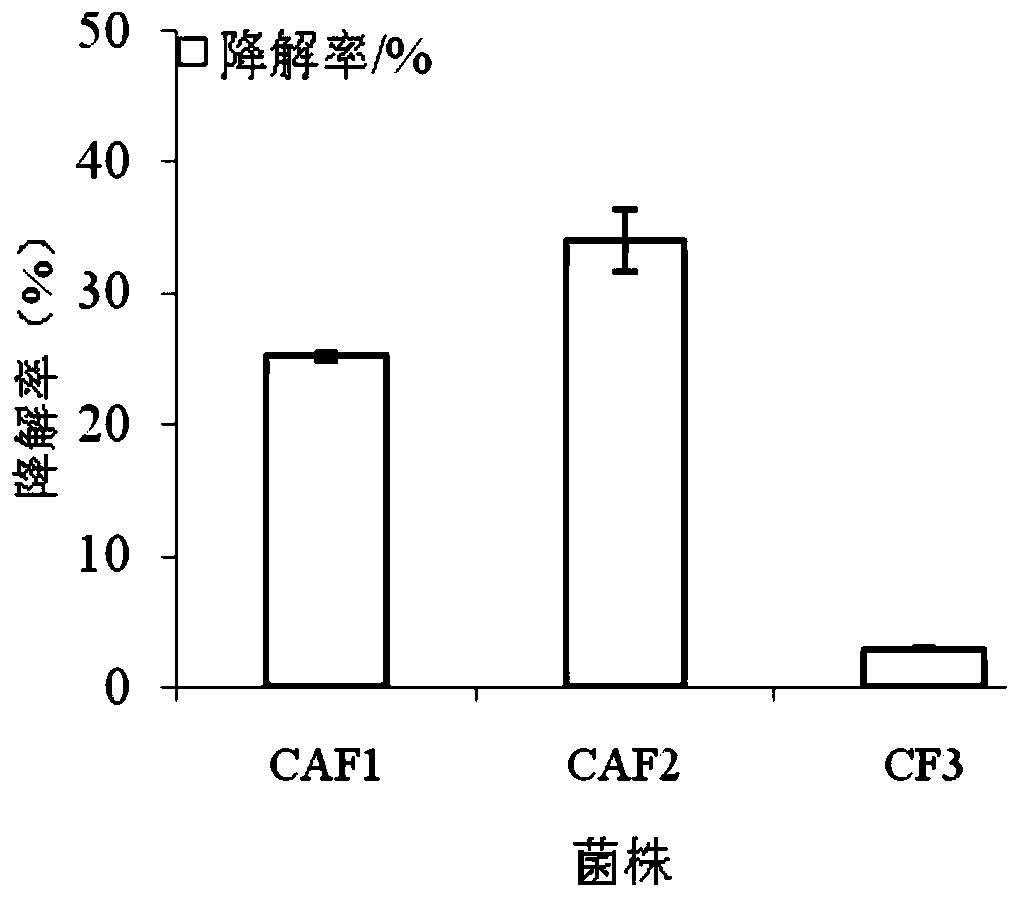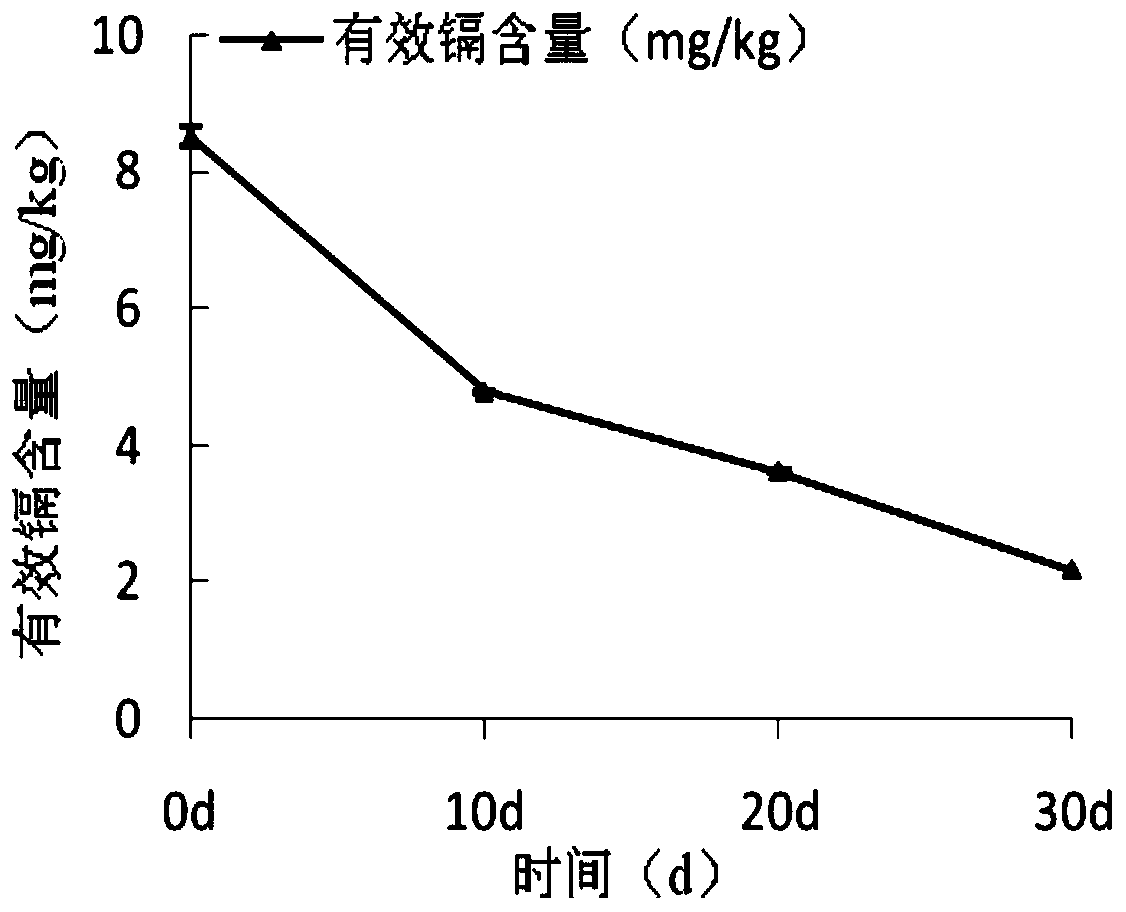Talaromycesveerkampii strain for degrading cellulose and adsorbing cadmium and application of strain
A technology for degrading cellulose and yellow-blue-like bacteria, which is applied in the field of environmental management to achieve the effect of repairing heavy metal pollution in soil
- Summary
- Abstract
- Description
- Claims
- Application Information
AI Technical Summary
Problems solved by technology
Method used
Image
Examples
Embodiment 1
[0027] Embodiment 1: This embodiment illustrates that the present invention uses culture medium
[0028] (1) Separation medium: CMC medium: sodium carboxymethylcellulose (CMC-Na) 10.0g, KH2PO4 0.25g, potato juice 100mL, agar powder 18.0g, distilled water 1000mL.
[0029] (2) Purification and storage medium: PDA medium: 200 g of potatoes, 20.0 g of glucose, 18.0 g of agar powder, and 1000 mL of distilled water.
[0030] (3) Cadmium ion-containing medium: 200g of potatoes, 20.0g of glucose, 18.0g of agar powder, and 1000mL of distilled water. Add cadmium ion-containing mother liquor (20mg / mL) as needed to prepare solid medium with different concentrations of cadmium ions.
[0031] (4) Screening medium:
[0032] a. Congo red medium: CMC-Na 2.0g, KH 2 PO 4 0.5g, MgSO 4 ·7H 2 O 0.25g, (NH 4 ) 2 SO 4 1.0g, Congo red 0.1g, agar powder 18.0g, distilled water 1000mL;
[0033] b. Re-screening medium: CMC-Na 5.0g, KH 2 PO 4 1.0g, MgSO 4 ·7H 2 O 0.5g, NaNO 3 3.0g, KCl0.5g...
Embodiment 2
[0035] Embodiment 2: the separation and purification of test bacterial strain
[0036] The specific method for the separation and purification of test bacterial strains in the present invention is: adopt the dilution plate coating method, the soil sample is made 10 by gradient dilution with sterile water -3 -10 -5 Bacterial suspension, and coated on the separation medium, placed in a constant temperature incubator at 26-28 ° C for 2-3 days, the isolated different fungal strains were streaked and purified in PDA medium, and the purified Good strains were stored in a refrigerator at 4°C.
[0037] The classification of the strain is named Talaromycesveerkampii (Talaromycesveerkampii) CAF2, its preservation number is: ACCC 32732, and its biological characteristics are: the colony texture is flocculent and fluffy, the edge is white to light yellow, the middle is light green, and produces yellow-green Spores; the optimum culture pH is 6.5; the optimum culture temperature is 28°C; ...
Embodiment 3
[0038] Example 3: Evaluation of cadmium ion tolerance of bacterial strain CAF2
[0039] The cadmium ion tolerance evaluation method of bacterial strain CAF2 of the present invention specifically comprises the following steps:
[0040] (1) Prepare PDA medium containing different cadmium ion concentrations, the concentration is set to 0, 10, 50, 80, 100, 150, 200 mg / L;
[0041] (2) Use a 5mm puncher to make bacterial cakes from the bacterial strain, inoculate it on the plate medium described in step (1) under aseptic conditions, and cultivate it in a constant temperature incubator at 26-28°C for 3-5 days to observe the growth of the bacterial strain. growing situation.
[0042] Strain CAF2 grows well on a plate with a cadmium ion concentration of 0-100 mg / L, but growth is completely inhibited on a plate with a cadmium ion concentration of 150 mg / L, so the cadmium ion concentration of the strain is tolerant The range is 0-100mg / L.
PUM
 Login to View More
Login to View More Abstract
Description
Claims
Application Information
 Login to View More
Login to View More - R&D Engineer
- R&D Manager
- IP Professional
- Industry Leading Data Capabilities
- Powerful AI technology
- Patent DNA Extraction
Browse by: Latest US Patents, China's latest patents, Technical Efficacy Thesaurus, Application Domain, Technology Topic, Popular Technical Reports.
© 2024 PatSnap. All rights reserved.Legal|Privacy policy|Modern Slavery Act Transparency Statement|Sitemap|About US| Contact US: help@patsnap.com










